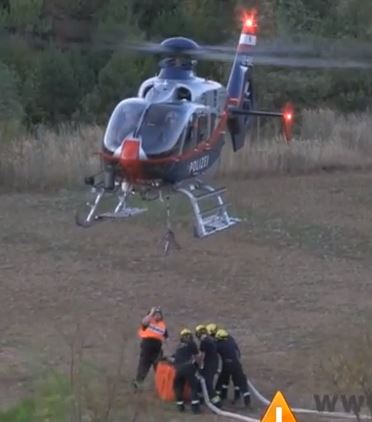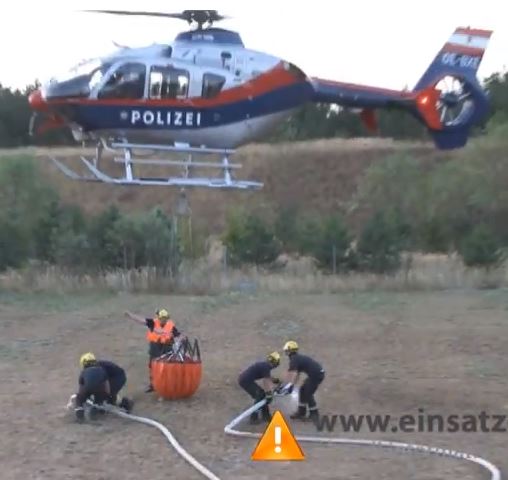Over on Wildfire Today an article about some recent wildfires in central Europe had these photos that were captured from a video, of firefighters in Germany using hoses to fill a helicopter’s bucket while the aircraft hovered overhead — a technique that was new to us.



Let see here……
Maybe to everyones chagrin here…….the distinct possibility exists that heliwellls and Bambi Buckets are not high on the Austrian PD’s want or current haves list.
That there Eurocopter is expensive enough and to add the expense of what folks here “have and “gots”” does not come under the extensive budgets US and Canadian operators have and maybe these folks are just getting into the arena of wildland fire with what exists on their MTOE for minumums without adding to the expense.
Maybe, even maybe Europe doesn’t have to have all the requirements that have developed here in the US, with all the added burdensome requirements of LMA’s and are, quite frankly, able to operate without the added expense of equipment and overhead teams to to even a simple mission as this in remote sites with available equipment, thus reducing the costs of setting up heliwells and carrying extra Bambis that some communities and jurisdictions just can afford…..especially this day in age!!
I’m probably misunderstanding your point, but it looks to me as if they already have the bucket. My guess is they have the well to fill it, but hadn’t yet taken the time to set it up. I would suspect they have everything they believe they need, but I doubt using hoses like that are the most efficient way to do the job.
Or is that the point?
Did this years ago with one of the old hard fiberglass buckets using a Mark 26 pump and hose out of a small stream. Cut turn-around time from 20 minutes to about 5 and prevented water loss from the leaking bucket. Sometimes you have to do unusual things to get the job done.
We use bambi-buckets to fill Stillwells (heli-wells) here in BC. Check out this demo clip on Youtube, http://youtu.be/kdMnm9hqdCM . This is particularly useful for refilling without having to flip a crewmemeber out to fill at a water source. One heli can support a few IA crews working in an area for classic BC lightning targets (ie, Steep with a tall canopy.).
Not always used, but another tool in the kit.
Without the optional SEI Bambi Bucket pump to get a full bucket, four feet of water. The larger Bambi Buckets eight feet of water. In open shallow water you can “drag” the bucket slowly on its side to obtain a portion of the buckets capacity. The fire fighters in the video are making it work just fine. There have been two remote fill from a pumped water source or hydrant devices invented. One is adaption of a Bambi Bucket with a cam lock the other for larger (2000 gallon) buckets Remote Aerial Refill Appliance. The SEI Heliwell is a brilliant idea, three people couple hours to assemble. In video; suggestion, maybe one fire fighter with hose filling. Use PVC and adapt a device that hangs over the buckets rim that will allow unrestricted filling. Paint the device bright pink (unless using retardant) so the pilot can make sure the hose has been remove and the aircraft is safe for forward flight. Clear hand signals from helispot fill manager a must.
Thanks. I have pumped into heliwells before, pretty amazing to have the Type 1’s rock a 50,000 lb tender when they lift a full bucket. Didn’t know about the smaller ships. We have quite a few open water sources in my area, though.
A question for my own my memory banks, How much depth does a Bambi bucket the size shown in the photos need to get full?
Our tenders have framed 3000 gallon Fol-Da-Tanks, 28″ from top to bottom of tank. Because you can rarely find a completely level piece of ground, they have about 24″ of usable water. Would they work as a dip site for a smaller (Type 3) bucket? I can easily rig to pump them full from 200-300 feet away with equipment we carry all the time on our tenders.
Like David says….no open water source
While the US marvels at all the great technology….it IS refreshing to see “good ole Yankee ingenuity” using what is available off site…
I am sure that is the the thought the Austrian were trying to portray also..
Bigger and more techno is not always better.
Like Mr Gabbert’s buddy, Don Rumsfeld says…….you get what I mean!!!
Just to clarify these photos are taken in Austria. Reason for filling the Bucket with Hoses is, that there is no large open water source available within a reasonable distance to the Fire to fill the Bucket.
Interesting. Do they not use heli-wells or collapsible tanks? Would seem to be way safer. Always interesting to see agencies around the world achieve the same goal using different means.
We do use heliwells and mobile tanks as well. To give a broader picture of this Incident (as far as i got told, couldnt attend it personally) 3 different Fires on the same Mountain, 2 on the western side in extremely steep terrain with nearly no cance to access it by foot and 1 raging on the eastern side in more accessible terrain. All in all 3 different Helos battled the fire. 2 Helos from the Austrian Air Force (Augusta Bell AB212, S-70 Black Hawk both with solid steel Buckets, around 780gal on the Black Hawk and approx 260gal on the AB212) on the western side and the EC-135 with a colapsible Bambi Bucket from Federal Police on the eastern.
the Heliwell got placed on the Eastern side of the mountain at a staging point from wich the fire got battled by Ground Units using multiple hand lines. Additionally multiple Pumper/Tanker ferried Water to the eastern Staging Point via forest road with some being used as stationary tanks for additional hand lines.
The EC-135 has been used as scout for both fires, to refill the Heliwell and dropped multiple loads on the more remote areas of the eastern fire.
sadly the fire district responsible for the eastern side of the fire is limited to one dedicated heliwell and it proved more effective to use it as described. Most of our wildfires are in very remote mountainous areas only accessible by foot or by helo and a constant supply of water proofed to be very effective cause the firefighting strategy mainly rests on a massive initial attack by ground forces and Helos to limit risk of property and life as much as possible. We do have fixed wing waterbombers (SEAT) as well but they are seldomly used due to limited landing options in the more mountainous areas of austria.
As for the Safety. Such Tactics are regularly trained by all involved Firefighting Units in close connection with civilian and military Aerial Firefighting Units. Each and everyone involved in the Heli Ops has proper experience how to act around the Helo. At least one Senior Supervisor is in charge of every drop and refill point and is constantly in direct contact with the Pilots of the Helos and Command Staff.
All of the FF are Voluntary Firefighters
Here are a few more Pics of the Heli Ops and the heliwell useage
http://bit.ly/11WYvEH
http://bit.ly/11WYVLo
http://bit.ly/165QeBy
http://bit.ly/13c1Y4U
http://bit.ly/1bmVfoY
http://bit.ly/1cX3uK7
oh and please excuse my bad english